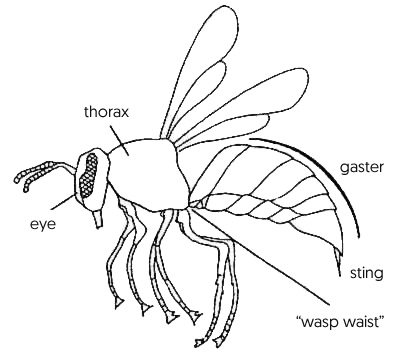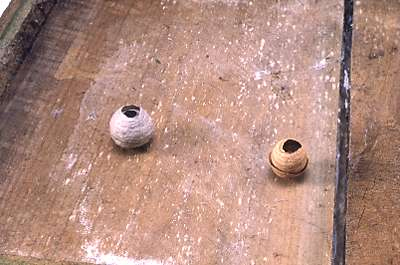Wasp identification
In this section

Diagram showing wasp body parts.
Order: Hymenoptera
Family: Vespidae
Subfamily: Vespinae
Genus: Vespula
Species: V. germanica V. vulgaris
Wasps, bees and ants (the order "Hymenoptera") differ from other insects by having two pairs of wings that are linked by a row of hooks, and by having a narrow "waist" that joins the abdomen to the thorax. The first segment of the abdomen is fused to the back of the thorax, so the part behind is not the whole abdomen — it is more strictly called the "gaster".
Social wasps can be distinguished from the rest of the Hymenoptera by:
- The way they fold their fore-wings back when they are at rest.
- By the pattern of veins on their wings.
- By having kidney-shaped compound eyes.
- Worker wasps and queens look similar, although the queen is much larger. Both have a sting.
- Drones do not have a sting, have more segments on the gaster, and have long curved antennae.
Workers, queens and drones
Worker
Most of the wasps in a nest are infertile female workers.
Queen
Queens, which are fertile females, look much the same as the workers, except they are about twice their size. They also have a sting.
Drones (male)
The males (called drones) have long antennae which often curve backwards. Their gaster has seven visible segments and is more evenly-shaped and longer than that of the females, and they have no sting.
Key differences between German and common Wasps
Common wasps are very efficient at harvesting honeydew have consequently displaced German wasps from honeydew beech forest. Common wasps collect honeydew at a faster rate than German wasps, and spend less time lapping honeydew (which has often fermented) from the trunk when the standing crop of honeydew is low, so that fewer of them become lethargic and less effective feeders.
Nests

German wasp (Vespula germanica) nest (L)
Common wasp (Vespula vulgaris) nest (R)
German wasp (Vespula germanica) nests are grey and made from the fibre of sound wood.
Common wasps (Vespula vulgaris) make their nests from the fibre of dead or rotten wood and are brown.

![Common wasps [Vespula vulgaris] Image](/assets/Discover-Our-Research/Biosecurity/Invasive-invertebrates/Vespula-Wasps-in-New-Zealand/Wasp_Queen__FillMaxWzE1LDE1XQ.jpg)
![Vein patterns on a [Vesapula] wing. Image](/assets/Discover-Our-Research/Biosecurity/Invasive-invertebrates/Vespula-Wasps-in-New-Zealand/Vesapula_wing__FillMaxWzE1LDE1XQ.jpg)
![[Vespula] eye shape. Image](/assets/Discover-Our-Research/Biosecurity/Invasive-invertebrates/Vespula-Wasps-in-New-Zealand/Vespula_eye_shape__FillMaxWzE1LDE1XQ.jpg)


![German wasp [Vespula germanica] face - black dots or a vertical black line. Image](/assets/Discover-Our-Research/Biosecurity/Invasive-invertebrates/Vespula-Wasps-in-New-Zealand/Vespula_germanica_face__FitMaxWzE1LDE1XQ.jpg)
![Common wasp [Vespula vulgaris] face - anchor-shaped mark. Image](/assets/Discover-Our-Research/Biosecurity/Invasive-invertebrates/Vespula-Wasps-in-New-Zealand/Vespula_vulgaris_face__FitMaxWzE1LDE1XQ.jpg)
![[Vespula germanica] head side-on – a complete yellow band behind the eye. Image](/assets/galleryimages/german_head_lateral__FitMaxWzE1LDE1XQ.jpg)
![[Vespula vulgaris] head side on - a black mark behind the eye. Image](/assets/galleryimages/vulgaris_head_lateral__FitMaxWzE1LDE1XQ.jpg)
![German wasp [Vespula germanica] - black dots on the abdomen, which are usually (but not always) separate from the black rings (variable). Image](/assets/Discover-Our-Research/Biosecurity/Invasive-invertebrates/Vespula-Wasps-in-New-Zealand/Vespula_germanica_dorsal_view__FitMaxWzE1LDE1XQ.jpg)
![[Vespula vulgaris] - black dots on the abdomen, which are usually (but not always) joined to the black rings (variable). Image](/assets/Discover-Our-Research/Biosecurity/Invasive-invertebrates/Vespula-Wasps-in-New-Zealand/Wasp_Queen-v3__FitMaxWzE1LDE1XQ.jpg)
![[Ancistrocerus gazella] Image](/assets/Discover-Our-Research/Biosecurity/Invasive-invertebrates/Vespula-Wasps-in-New-Zealand/Ancistrocerus_gazella__FitMaxWzE1LDE1XQ.jpg)

